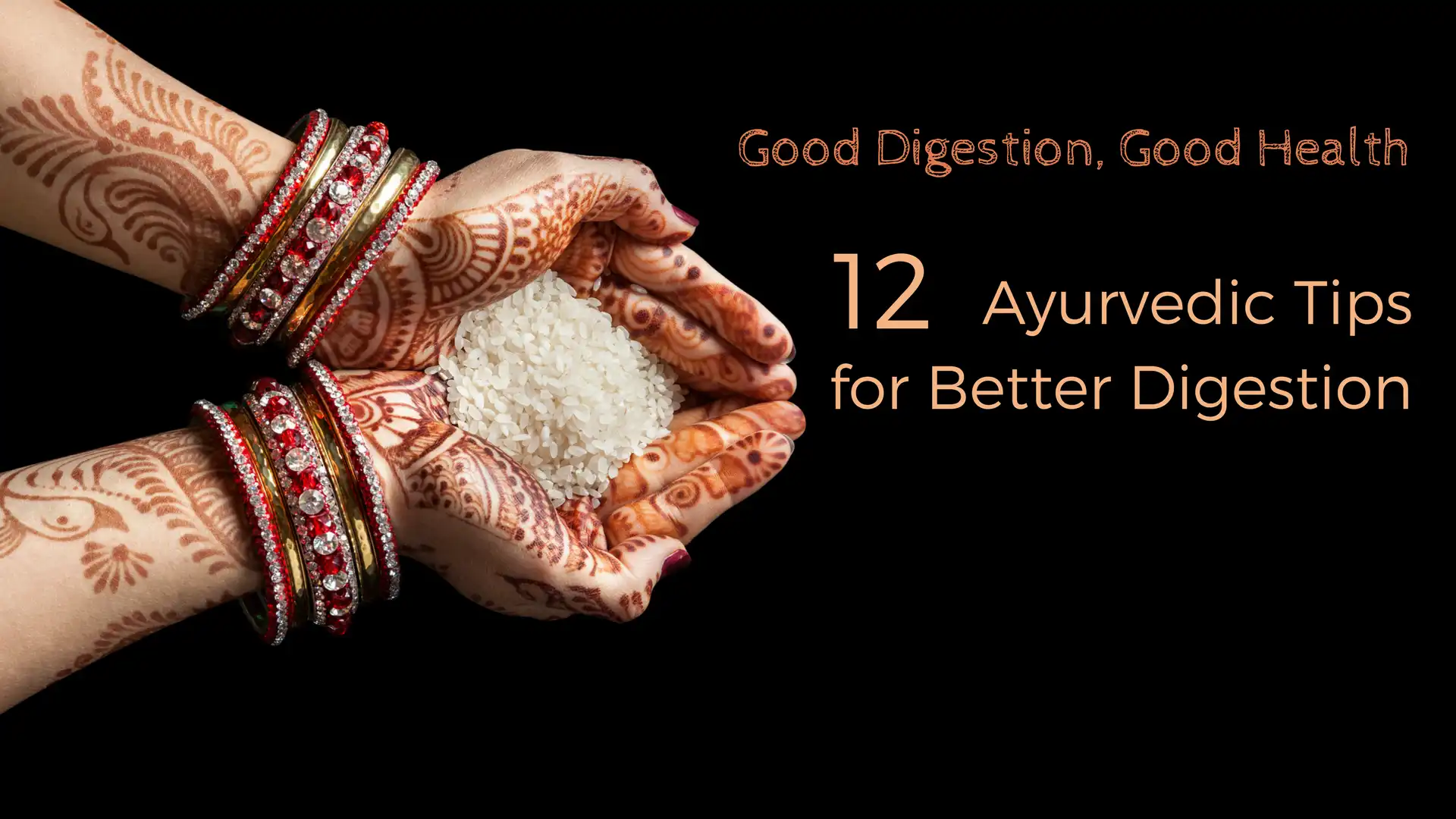Good Digestion, Good Health: 12 Ayurvedic Tips for Better Digestion

A lot of us really care about what we eat. We buy organic, avoid GMOs, boost our antioxidants, and evaluate glycemic indexes—all factors relating to the quality of the food entering our bodies.
Props to us for doing our research and making healthy choices, but it’s all done in vain if we don’t give as much attention to the process of eating itself. It’s not only what we eat, but also how we eat that matters.
Ayurveda—the science of life—teaches us how to eat.
This concept may at first seem a little silly. After all, we’ve got decades of practice under our belts!
But let’s face it. The norm in our busy American lives is eating in the car, while standing up, when we’re stressed, when we’re in a rush, and chowing down on cold leftovers straight from the fridge. Under these conditions, we don’t digest properly and even the most wholesome food becomes unwholesome to the body.
For this reason, Ayurveda gives us upayoga samstha, the art of eating. Here are the guidelines:
-
Eat when your food is warm. Food shouldn’t be too hot or too cold. Warm food ensures we don’t snuff out the agni (digestive fire) and makes for good digestion.
-
Eat freshly cooked food. Fresh food is full of prana (life force) and nutrients. These start to diminish soon after food is cooked. By the time food becomes a leftover, its properties have changed and it’s heavy for the body to digest. Cooking every single meal may not be realistic, but at least try to avoid food that’s been cooked more than 24 hours before.
-
Eat the right quantity of food. Overeating leads to indigestion and undereating leads to loss of strength. There’s no standard amount that’s right for everyone because we’re all different sizes and have different needs. Find your right amount by filling your belly 50 percent with food, 25 percent with liquids, and leave 25 percent empty for digestive action.
-
Chew your food thoroughly and eat at a moderate pace. Digestion starts in the mouth. Chewing your food properly makes it easier for the rest of the system to process it.
-
Wait until the previous meal is digested before eating again. Ayurveda says that feeding the system too soon is a major cause of ill health. How do you know if your food is digested? You should feel light, enthusiastic, hungry, and thirsty.
-
Eat at around the same time each day. The body thrives on routine. The digestive system does well when it can expect its meals at a certain hour. Then it’s prepared and ready for action.
-
Eat when you’re hungry. Hunger (meaning true hunger, not the munchies) is a natural urge that should not be suppressed. Once you’ve got an eating routine going, you’ll find that you’re hungry when it’s mealtime and won’t crave snacks. Nonetheless, listen to your body’s hunger cues when given.
-
Never eat when you’re upset. Wholesome food will lose its wholesomeness in the digestive tract if it’s eaten when you’re in a negative state of mind. If you’re upset, angry or crying, postpone eating until you feel better.
-
Eat in a quiet, settled atmosphere. A calm environment promotes a calm mind, and the state of mind has a direct impact on the physical body and the process of digestion.
-
Always sit down to eat. Try your best not to eat in the car, while walking, or even while standing. The body doesn’t want to multitask when you’re eating. Sitting ensures that all your energy is given to digestion.
-
Concentrate on your food. When you give it your full attention your food will taste better, you’ll enjoy it more, and you’ll be less tempted to overeat because you’ll notice those cues of satiation. Avoid distractions like eating in front of the TV, or while you’re reading or working.
-
Sit for a few minutes after each meal. Don’t eat and run. Relax and just be for a little while to let your digestive system do its thing.
These guidelines are simple but make a big difference. When you chose seasonal, local, organic foods appropriate for your body and eat them in the right manner, your body can process the food the way it’s supposed to. And according to Ayurveda, good health starts with good digestion.
You can study more about digestion and Ayurveda in the YogaUOnline course with Dr. Suhas Kshirsagar – Ayurveda, Digestion, and Detoxification: Keys to Lifelong Health and also The Art of Self Care – Ayurvedic Tools for Fostering Balance and Well-being.
Need more Ayurvedic tips for good health? Three Tips to Stay Balanced with Yoga and Ayurveda.
reprinted with permission from True Ayurveda

Julie Bernier teaches women the art of self-care so that they feel their healthiest and happiest in their own unique bodies. This holistic approach to individualized wellness is rooted in the ancient Indian knowledge of Ayurveda: a complete medical science and way of life which explains that our wellbeing blossoms when we align ourselves with nature. Julie is a registered ayurvedic practitioner with the National Ayurvedic Medical Association (NAMA), a Certified Massage Therapist, and a classical hatha yoga teacher. She studied each of these modalities in the US and straight from the source in India. Julie also shares Ayurveda and yoga through writing and is the author of Yoga for Health and Happiness.
References:
Archana I, Praveen, and Mahesh Vyas. “A Light on Dietetic Rules in Ayurveda.” Ayurpharm IJAAS 1.1 (2012): 30-37. Ayurpharm. Web. 17 Aug 2013.
Tiwari, Maya. Ayurveda: A Life of Balance. Rochester: Healing Arts Press, 1995. Print.



